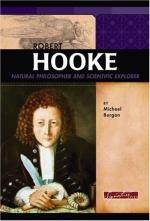|
This section contains 358 words (approx. 2 pages at 300 words per page) |
World of Mathematics on Robert Hooke
Robert Hooke was a typical scientist of his times - his interests ranged widely over all areas of science. Some of his main contributions were in the fields of optics and mechanics. Hooke was instrumental in the thinking of Isaac Newton as he formulated his laws of planetary motion. Hooke is also responsible for Hooke's law of elasticity and he was the inventor of the conical pendulum.
Robert Hooke was born in Freshwater in England in 1635. His initial education was carried out at Westminster School in London and then from 1653 at Christ Church, Oxford. In 1655 Hooke was employed by Robert Boyle in the construction of an air pump. 1660 was the year Hooke discovered his law of elasticity. In 1663 Hooke was elected a Fellow of the Royal Society (London). In 1665 Hooke became professor of geometry at Gresham College, Oxford. In 1665 Hooke published Micrographica which was a catalogue of objects studied by Hooke under a microscope he had constructed himself. Using this machine Hooke was the first person to observe and recognise cells in living material. Although he was initially on friendly terms with Newton and other noted scientists of the day (he carried on a lengthy correspondence with Newton discussing the motion of heavenly bodies as a problem of dynamics) Hooke was jealous and vain. He accused Newton and Christiaan Huygens of stealing his work. In addition to the above Hooke also made numerous astronomical observations using a self made telescope, he was also assistant to Charles Wren in the rebuilding of London after the great fire of 1666. Hooke also had several watches made to his own designs, as well as making the most accurate spring balance of its time. He also made a mathematical calculating machine and he invented a primitive type of telegraph machine. Hooke also recognised that fossils were petrified versions of once living organisms and that the fossil record was actually a record of changes that had occurred throughout the life of the planet. Hooke is perhaps best known for his contributions to biology in Micrographica rather than his extensive efforts in other fields. Hooke died in London at the age of 66 in 1702.
|
This section contains 358 words (approx. 2 pages at 300 words per page) |


